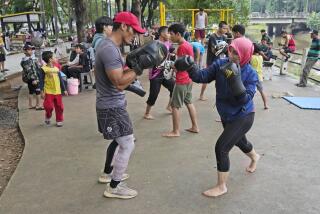Antidote to Mugging Isn’t Pretty : Jewish Self-Defense System Called Krav Maga Is Simple, Swift, Street-Oriented
- Share via
COSTA MESA — The knife-wielding man lunged at his opponent. One hard upward jab and the weapon’s blade would slice into the soft flesh under the man’s chin.
But the would-be victim was having none of it. Using forearms and hands, he neatly deflected the attacker’s lunge, punched him hard in the chest and then quickly delivered a stinging kick to the groin that was felt empathetically around the room.
“I’m striking more than once,” the man calmly explained, “because that’s the way it is in the streets. You must defend and finish.”
The potentially deadly altercation was, in fact, a simulation. But in its swift and efficient economy of movement could be seen the basic philosophy of Krav Maga, the Jewish self-defense system.
“We don’t worry about looking pretty or moving smoothly,” instructor Mitch Markowitz said. That is one of the aspects, he said, that separates the Jewish discipline from some of its Asian counterparts. “We emphasize what works.”
For many years, Krav Maga--Hebrew for “contact combat”--has been the official martial arts system employed by the Israeli Defense Forces, anti-terrorist units and various branches of the Israeli National Police Force. Now it has taken on a new incarnation: as the latest rage among Southern Californians looking for an antidote to mugging.
“We don’t grade them on style,” Markowitz reiterated. “If someone is attacked in the street, we expect them to kick to the groin, scratch at the eyes, pull out the hair--anything to get away and avoid being hurt.”
The practicality of its approach stems, in part, from the system’s origins in Bratislava, Czechoslovakia, during the 1930s. It was there that Imi Lichtenfeld, a champion wrestler, boxer, gymnast and son of the chief martial arts instructor of the Czechoslovakian national police force, learned during skirmishes with Nazi youth gangs that fighting by the rules doesn’t always work, especially when one is outnumbered.
Later Lichtenfeld escaped the Nazis, emigrated to Israel in 1948 and spent the next several years developing and refining Krav Maga (pronounced krahv ma-GAW), eventually as chief instructor for physical fitness and hand-to-hand combat of the Israeli Defense Forces and author of the government’s manual on self-defense.
Although the grand master retired from military service in 1963, the system Lichtenfeld invented continues to be taught by his successors today. One of them, Darren Levine, brought Krav Maga to Los Angeles County, where it has been taught since 1981 to an estimated 5,000 people, mostly at Jewish community centers, private day schools, universities and special academies in Los Angeles, Northridge, La Canada Flintridge, Santa Monica, Encino and Long Beach. In addition, several law enforcement agencies have adopted the Israeli techniques, among them the Beverly Hills and El Segundo Police departments and the U.S. Coast Guard’s drug interdiction unit.
While Krav Maga classes also exist in Philadelphia, New York and Boston, Southern California seems to have become the system’s unofficial capital in the United States, says Levine, a 32-year-old Los Angeles County deputy district attorney. “It grew up in (the L.A. area) more than anywhere else,” he said. “It became very successful here.”
Because of Southern California’s cultural diversity, Levine said, only about half of the 5,000 trainees are Jewish. “I wanted to see it branch out,” he said. “Israel needed to have friends with all different kinds of backgrounds. We wanted to make the Jewish community stronger, but we wanted people from all backgrounds to train together and learn together. We’ve developed a nice family.”
The latest Krav Maga class began meeting last month at the Jewish Community Center of Orange County in Costa Mesa. Taught by Markowitz, a Huntington Beach computer systems integrator, and Michael Leifer, a Newport Beach attorney, the class has 30 members, only about a third of whom are Jewish.
“What I like is (the system’s) simplicity and ease of learning,” said Leifer, 30, who spent six years studying karate before taking up Krav Maga. More street-oriented than Asian defense systems such as jujitsu and karate, he said, Krav Maga emphasizes real-life responses to attacks by armed or unarmed foes who may be stronger and greater in number. Compared to its Asian counterparts, he said, the Jewish system requires fewer movements, swifter action and less strength to perform.
Thus, Leifer says, “the techniques can be taught to people who aren’t athletes.”
Members of the new 10-week class range in age from 7 to 60-plus years and include five women.
To teach them, Markowitz and Leifer employ a series of simulated real-life attacks using such “weapon” props as a wooden knife, large club and a handgun replica that shoots only air. In addition, they sometimes turn off the lights to simulate nighttime, and they encourage students to actually slap or punch each other whenever inadequate defense techniques allow.
“We don’t want anyone to get hurt,” Leifer said, “but we want them to know that if they don’t defend themselves they will get hit.”
The result is a class that, at times, looks and feels something like a gigantic Jewish street brawl.
“You’re cheating the punch,” one instructor yelled during a recent Tuesday night exercise requiring participants to divide into pairs and hit punching bags held by their partners. “Put your weight into the punch!”
Sweating freely in their athletic garb, the weary students tried to comply.
“I’ve always wanted to do this,” said Patty Borgerdine, 30, a quality assurance engineer from Fountain Valley. “This will give me more self-assurance when I’m out alone at night. What I’ve learned is that you don’t have to be powerful to defend yourself.”
Mike Clark, a 41-year-old mortgage broker from Anaheim, couldn’t have agreed more. “Things are getting tougher in the streets,” he said. “Just minding your own business now, you can get in trouble.”
Which is exactly the point, according to Markowitz, the man wielding the knife in the simulated attack. “It’s not a sport,” he says of the Jewish self-defense system. “We try to make it as realistic as possible. We’re doing this because we think it works.”
More to Read
Go beyond the scoreboard
Get the latest on L.A.'s teams in the daily Sports Report newsletter.
You may occasionally receive promotional content from the Los Angeles Times.










